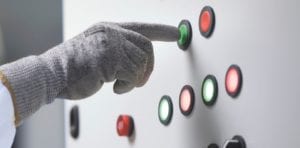Most of the time, the electrical power in your building or factory keeps on flowing. The lights stay on, computers keep working, production lines or processes keep running. Occasionally, you may experience an outage due to a problem on the utility side, such as a blackout or other kind of disturbance on the transmission or distribution grid. Hopefully, these are few and far between. If you’re running a critical facility, you likely have some form of backup power system, including a UPS, to ride through those kinds of events.
If you think that things are going great and there’s nothing more your facility team needs to worry about, don’t be fooled. Within your infrastructure are hidden power and equipment conditions that could put the reliability of your operation at risk. Unlike external events on the utility grid, the risks I’m talking about occur at the ‘edge’ of the power chain, from where electricity enters your facility, down to each and every load consuming it.
These risks are typically not obvious. There will be no outward signs of a potential failure about to occur. Without the proper tools in place to detect them, you often only realize something’s gone wrong after the failure has occurred and everything shuts down. This sends your facility operations and maintenance teams scrambling to determine the source of the issue and, in turn, get the lights on again as fast as possible. This can be a time-consuming and stressful experience if you don’t have all the necessary information to help.
Power management systems are designed for this very purpose. They act as a microscope into your power distribution system, watching over everything 24/7. They alert your team when risks surface and give you the information and analysis tools to quickly isolate problems and get things going again. Some of the newest available systems go even further by helping you avoid risks in the first place. Let’s take a look at some common causes of power outages, and solutions to help you deal with them.
Common causes of power outages
Power outages can happen due to several factors:
- Weather conditions: Storms, lightning, and high winds can damage power lines and equipment.
- Equipment failure: Aging infrastructure or malfunctioning components may lead to outages.
- Human error: Accidental damage during construction or maintenance can interrupt the power supply.
- Overloading: Excessive demand on the grid can cause disruptions.
Implementing solutions to power outages can help mitigate these issues. Let’s look at 5 ways to efficiently deal with power outages.
How to handle a power outage
1. Keeping an eye on equipment
While commissioning a new power management system for one the world’s largest wastewater treatment plants, it was discovered that a tie breaker in one substation was closed across the dual incoming feeds from the transmission system. Normally, this would only occur if the active incoming feed had failed, which was not the case. Further, a blown fuse was discovered on the other incomer, essentially losing the dual incomer redundancy. This could have had serious effects on the plant’s ability to treat wastewater.
If the power management system had been in place earlier, this situation could have been detected quickly and resolved. Power management systems are able to do this by integrating a complete model of a facility’s power distribution system, with all incomers, mains, feeders, sub-feeders and loads defined. Connected devices are used to accurately and continuously monitor all conditions at every key point, including the status of protection and switching devices like tie breakers. If any unexpected state change is detected, an alarm notifies personnel wherever they are so that they can immediately locate the issue and take action to prevent a critical situation.
2. Keeping an eye on power quality
For semiconductor manufacturers, power anomalies can have a huge impact on the reliability and quality of output. A power management system will analyze the quality of the electrical power throughout a plant, categorizing these events against industry-standard tolerance curves (e.g. CBEMA/ITIC, SEMI-F47). If an event falls outside of acceptable tolerances – e.g. a sag in voltage deeper than 80% and longer than 50 ms –the operation team will be alerted. They can then decide if the risk is too great to continue a process that could result in substandard product and, in turn, waste time, materials, and money.
In another example of a power-sensitive operation, consider a hospital that was beginning to have problems with their blood dialysis machines. Staff guessed that it must be a power problem, but they weren’t sure. Once a power management system was in place, its distributed power quality monitors and analytic tools quickly revealed that the distribution system had a high level of power harmonics. The source was a set of variable-speed drives that had recently been installed to boost energy efficiency. If the power management system had been in place sooner, this condition could have been proactively instead of reactively identified, and the whole problem would have been avoided.
3. Getting to the root of a power problem
Imagine an industrial plant with a large motor that’s causing a voltage sag on the power distribution system every time it starts up. This sag is causing sporadic equipment mis-operation and failures in other parts of the plant. A power management system can perform efficient root cause analysis for these kinds of acute and chronic events.
Intelligent, connected devices throughout the power distribution systems capture and log all kinds of power events that exceed predefined thresholds. These devices can be standalone meters, or metering functions embedded inside smart circuit breakers. All of this data is continuously uploaded to a central analytic application.
Some of the newest power management systems will automatically correlate system-wide data, including events, status changes, and captured waveforms. In addition, accurately time-synchronized alarm and event ‘clustering’ may also be used to more quickly reveal the propagation of a power disturbance. In this way, the source of an equipment failure or power outage can be quickly isolated, the appropriate response determined, and the issue resolved to prevent future occurrences.
4. Preventing electrical fires and failures
The NETA stated that a major insurance carrier estimates approximately 25% of all major electrical failures are due to loose or faulty (e.g. corroded) connections. That’s a big number. The problem with bad connections is that they cause heat and heat causes fires. Annual infrared scans can help identify such issues, but new technologies are emerging to help facility teams stay on top of important connection points on a continuous basis.
Wireless thermal sensors are installed in locations such as busbars, and where circuit breakers and transformers are connected. These transmit data to the central power management application, which constantly watches for any signs of abnormal temperature rises on one or more conductors. In this way, early detection can avoid the risk of a fire or failure. This predictive maintenance approach can increase the MTBF of each electrical switchboard, as well as avoiding the time and cost of annual IR testing.
5. Extending circuit breaker performance and life
The reliable operation of circuit breakers is critical for human safety as well as protecting equipment. To ensure this, regular maintenance on each circuit breaker is typically done on a scheduled basis. However, some smart circuit breakers and power management applications now offer analytic capabilities that support a more proactive, condition-based approach.
Embedded intelligence within each circuit breaker enables logging of a wide variety of parameters, including number of trips and the interrupted current profile for each. These are continuously uploaded to the analytic application where an algorithm combines this with data on the breaker’s environmental conditions, such as temperature, humidity, presence of corrosive gases, salt, etc. The result is a more complete picture of breaker health and aging. This insight helps reveal performance issues, extends breaker life, and potentially reduces maintenance costs by enabling service to be done on a predictive rather than scheduled basis.
EcoStruxure™ Power from Schneider Electric is a unified power distribution and management architecture that includes the connected devices and analytic capabilities needed to maximize uptime by staying on top of equipment and power quality conditions, as well as quickly isolate risks or problems and support condition-based maintenance strategies.




Conversation
Thanks for these very useful tips. Today, with businesses storing all types of data, including key, sensitive ones, on servers, focusing on power management has become more important than ever before. This is even more so for data centers, managing multiple servers and huge amounts of stored data. Tracking and monitoring Power Usage Effectiveness (PUE) is a crucial way not just to ensure maximum uptime and limit loss of data, but to also save costs. With the availability of energy and power management software solutions, this has become easy. In fact, access to real time data and alerts can help prevent a major disaster.
Informative